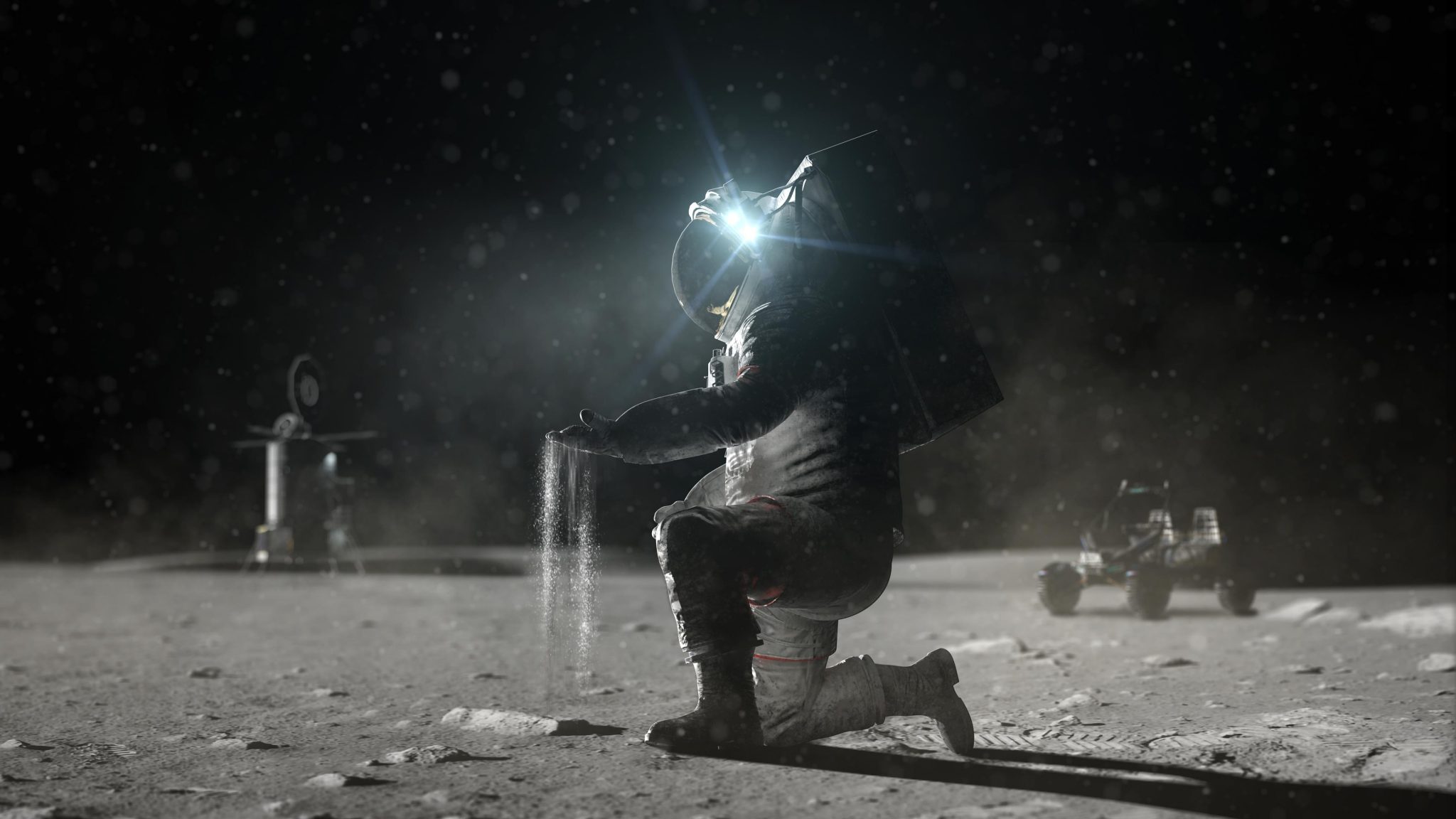
NASA의 Advanced Concepts Laboratory에서 시각화한 먼지 투성이의 달 풍경. 크레딧: NASA
추운 겨울날, 태양의 따스함이 가장 반갑습니다. 그러나 인류가 점점 더 많은 온실 가스를 방출함에 따라 지구의 대기는 점점 더 많은 태양 에너지를 가두어 지구를 꾸준히 따뜻하게 합니다. 이 추세를 역전시키는 한 가지 전략은 햇빛이 지구에 도달하기 전에 일부 햇빛을 차단하는 것입니다. 수십 년 동안 과학자들은 스크린, 물체 또는 먼지 입자를 사용하여 지구 온난화의 영향을 완화하기 위해 1~2%의 태양 복사를 충분히 차단하는 것을 고려했습니다.
유타 대학이 주도한 한 연구는 햇빛을 차단하기 위해 먼지를 사용할 가능성을 탐구했습니다. 그들은 먼지 입자의 다양한 특성, 먼지의 양, 그림자 지구에 가장 적합한 궤도를 분석했습니다. 저자들은 지구에서 지구-태양 “라그랑주 지점”(L1)으로 가는 도중에 있는 스테이션으로 먼지를 쏘는 것이 더 효율적이지만 천문학적인 비용과 노력이 필요하다는 것을 발견했습니다. 대안은 달가루를 사용하는 것입니다. 저자들은 달에서 방출되는 달 먼지가 지구에 그림자를 드리우는 저렴하고 효과적인 방법이 될 수 있다고 주장합니다.

지구와 태양 사이의 먼지 흐름 시뮬레이션 방출. 이 먼지 구름은 지구에서 태양의 원반을 통과할 때 나타납니다. 달 표면에서 방출되는 것을 포함하여 이와 같은 흐름은 태양을 위한 임시 우산 역할을 할 수 있습니다. 출처: Ben Bromley/유타 대학교
천문학자 팀은 그들의 일반적인 연구 초점인 먼 별 주위의 행성 형성을 연구하는 데 사용되는 기술을 적용했습니다. 행성 형성은 호스트 별 주위에 고리를 형성할 수 있는 많은 우주 먼지를 방출하는 혼란스러운 과정입니다. 이 고리는 중앙 별에서 나오는 빛을 가로채서 우리가 지구에서 감지할 수 있는 방식으로 다시 방출합니다. 새로운 행성을 형성하는 별을 발견하는 한 가지 방법은 이러한 먼지 고리를 찾는 것입니다.
물리학 및 천문학 교수이자 이 연구의 주저자인 Ben Bromley는 “그것이 아이디어의 씨앗이었습니다.”라고 말했습니다.

라그랑주 지점 1의 웨이스테이션에서 방출된 먼지 시뮬레이션. 명확성을 위해 지상의 그림자가 과장되었습니다. 크레딧: 벤 브롬리
천체 물리학 센터의 연구 공동 저자 인 Scott Kenyon은 말했습니다. 하버드와 스미소니언.
이 논문은 최근 저널에 게재되었습니다. 플로스 기후.
캐스트 그늘
방패의 전반적인 효과는 지구를 가리는 궤도를 유지하는 능력에 달려 있습니다. 학부생이자 이 연구의 공동 저자인 Sameer Khan은 오비탈이 충분한 음영을 제공할 수 있을 만큼 충분히 오랫동안 먼지를 제자리에 가둘 수 있다는 초기 탐색을 주도했습니다. Khan의 작업은 먼지를 원하는 곳에 보관하는 것이 어렵다는 것을 보여주었습니다.
“우리는 태양계의 주요 천체의 위치와 질량을 알고 있기 때문에 중력의 법칙을 사용하여 시간이 지남에 따라 여러 다른 궤도에서 태양 보호막의 시뮬레이션 위치를 추적할 수 있습니다.”라고 Khan은 말했습니다.
두 가지 유망한 시나리오가있었습니다. 첫 번째 시나리오에서 저자는 중력이 균형을 이루는 지구와 태양 사이의 가장 가까운 지점인 L1 라그랑주 지점에 우주 플랫폼을 배치합니다. 라그랑지안 점에 있는 물체는 두 천체 사이의 경로를 따라 머무르는 경향이 있습니다.[{” attribute=””>James Webb Space Telescope (JWST) is located at L2, a Lagrange point on the opposite side of the Earth.

A simulation of dust launched from the moon’s surface as seen from Earth. Credit: Ben Bromley
In computer simulations, the researchers shot test particles along the L1 orbit, including the position of Earth, the sun, the moon, and other solar system planets, and tracked where the particles scattered. The authors found that when launched precisely, the dust would follow a path between Earth and the sun, effectively creating shade, at least for a while. Unlike the 13,000-pound JWST, the dust was easily blown off course by the solar winds, radiation, and gravity within the solar system. Any L1 platform would need to create an endless supply of new dust batches to blast into orbit every few days after the initial spray dissipates.
“It was rather difficult to get the shield to stay at L1 long enough to cast a meaningful shadow. This shouldn’t come as a surprise, though, since L1 is an unstable equilibrium point. Even the slightest deviation in the sunshield’s orbit can cause it to rapidly drift out of place, so our simulations had to be extremely precise,” Khan said.
In the second scenario, the authors shot lunar dust from the surface of the moon towards the sun. They found that the inherent properties of lunar dust were just right to effectively work as a sun shield. The simulations tested how lunar dust scattered along various courses until they found excellent trajectories aimed toward L1 that served as an effective sun shield. These results are welcome news, because much less energy is needed to launch dust from the moon than from Earth. This is important because the amount of dust in a solar shield is large, comparable to the output of a big mining operation here on Earth. Furthermore, the discovery of the new sun-shielding trajectories means delivering the lunar dust to a separate platform at L1 may not be necessary.
Just a moonshot?
The authors stress that this study only explores the potential impact of this strategy, rather than evaluate whether these scenarios are logistically feasible.
“We aren’t experts in climate change, or the rocket science needed to move mass from one place to the other. We’re just exploring different kinds of dust on a variety of orbits to see how effective this approach might be. We do not want to miss a game changer for such a critical problem,” said Bromley.
One of the biggest logistical challenges—replenishing dust streams every few days—also has an advantage. Eventually, the sun’s radiation disperses the dust particles throughout the solar system; the sun shield is temporary and shield particles do not fall onto Earth. The authors assure that their approach would not create a permanently cold, uninhabitable planet, as in the science fiction story, “Snowpiercer.”
“Our strategy could be an option in addressing climate change,” said Bromley, “if what we need is more time.”
Reference: “Dust as a solar shield” by Benjamin C. Bromley, Sameer H. Khan and Scott J. Kenyon, 8 February 2023, PLOS Climate.
DOI: 10.1371/journal.pclm.0000133
